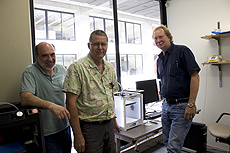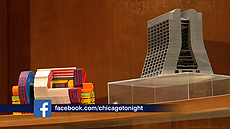How a model of Wilson Hall made it on local TV
 |
From left: Paul Rubinov, David Huffman and Michael Utes created the 3-D-printed model of Wilson Hall that now lives on the set of Chicago Tonight. Photo: Ashley Black, OC |
Wilson Hall dominates the skyline of Fermilab's site, and it now has a place in Chicago as well. A 3-D-printed version of the high-rise sits on the bookshelf on the set of the television program Chicago Tonight alongside other signature Chicago memorabilia.
The model made its debut on Monday, July 20, along with a 3-D-printed model of the CMS detector, one of the four main detectors gathering data at the Large Hadron Collider at CERN.
The idea to include the icons came to Fermilab scientist Don Lincoln when he visited WTTW in December and spoke with one of the cameramen.
"He looked at the wall of artifacts behind the set and said something along the lines of, 'You know … we don't have any science stuff up there.' And that got me to thinking," Lincoln said.
Lincoln commissioned James Wetzel from the University of Iowa to make a 3-D-printed model of the CMS detector earlier this year. Later, Lincoln and a team consisting of David Huffman, Paul Rubinov and Michael Utes from Fermilab were inspired to do the same for Wilson Hall, perhaps the most recognizable structure at the laboratory.
The basic concept of a 3-D printer is simple: You design something on a computer, transform it into a file the printer can read and upload it. In this case, Huffman used original electronic drawings of Fermilab's floor plans and converted them to 3-D in AutoCAD.
"The hard part was deciding what parts of the floor plan drawing to ignore, because we were just making the shell of Wilson Hall," Huffman said.
Each floor was printed separately to avoid potential large printing errors.
"You sometimes have to babysit the older printers," Utes explained.
Utes, Rubinov and Huffman took turns watching over the printer, which generated one to two floors per day throughout the two-week-long process. Each floor took about four hours to print.
The team glued together the completed floors with plastic pipe glue before the model, about the size of a coffee can, was sent to its new home in the Chicago television studio.
As for how long Wilson Hall might represent the lab on the shelf, Lincoln is optimistic.
"I think it's going to be up for the long haul," he said.
—Ashley Black
 |
3-D models of the CMS detector and Wilson Hall can now be seen on WTTW's Chicago Tonight. Go to minute 46 of the July 20 episode to see the models. |
|